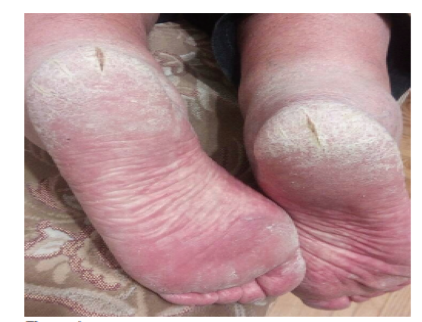Hyperkeratosis and Painful Fissuring on the Soles
By Ted Rosen, MD, FAAD
CASE HISTORY

A 69-year-old postmenopausal obese Caucasian woman of Russian ethnicity presented with the recent onset of thickened skin in the bilateral plantar surfaces. This phenomenon was particularly prominent on the heels and less apparent on the arch of both feet.
She was especially distressed as the involved areas would often develop painful fissures, which impaired normal ambulation. Pruritus was never associated with the problem.
She had tried applying a common over-the-counter Vaseline-based moisturizer to no avail. There were no cutaneous abnormalities elsewhere, and she denied the presence of similar lesions in either of her adult sons or her younger siblings.
Review of systems was entirely benign and past medical history revealed only well-controlled hypertension, for which she regularly took a low dose beta-blocker (metoprolol). She specifically denied ingesting diuretics. Social history revealed that she worked exclusively at home, while sitting, as a tailor. She specifically denied vigorous exercise or participating in activities such a hiking or power walking. Her typical daily footwear consisted of white-colored gym shoes manufactured by Nike.
Physical examination revealed markedly hyperkeratotic heels. Within the thickened skin were small but deep fissures, which were extremely tender to the touch. (See Figure 1) There were extremely mild, rough hyperkeratotic patches palpable on the arch of both feet, but no fissures noted in that area. There was no inguinal adenopathy detected. The palms were normal. A biopsy was not performed.
What is your diagnosis and how would you help her?
DISCUSSION
The diagnosis is keratoderma climactericum, an acquired form of keratoderma first described by Haxthausen in 1934.1
This unusual disorder appears in postmenopausal women and is characterized by hyperkeratosis and painful fissuring on the soles. Eventually, the palms are typically affected in a similar manner.
Most patients are obese and hypertensive, as was this individual. The exact pathogenesis is unknown, but it is believed to relate in some manner to hormonal dysregulation.
Although exogenous estrogen administration has been successful in some cases, this therapeutic intervention is not always successful. Other treatments, which can be used successively or in combination include oral retinoids, topical steroids and topical formulations containing salicylic acid, lactic acid, or urea.
This debilitating condition is usually diagnosed by a thorough history and routine physical examination. Onset at postmenopausal age and negative family history preclude the diagnosis of the various forms of hereditary keratoderma. However, the differential diagnosis includes psoriasis, atopic dermatitis, allergic and irritant contact dermatitis, tinea pedis, cancer-associated tylosis and pityriasis rubra pilaris. A potassium hydroxide preparation and fungal culture, as well as a biopsy, may uncommonly be required to exclude some of the other diagnostic considerations and therefore verify the diagnosis.
This patient was managed with low dose acitretin (10mg/day) concurrent with twice daily application of a salicylic acid-containing moisturizer (CeraVe-SA Cream). Fissures were specifically protected with Vaseline before each application of the keratolytic cream. In six months, her keratoderma had resolved.
Reference:
- Haxthausen H. Keratoderma climactericum. Br J Dermatol 1934;46:161-7


